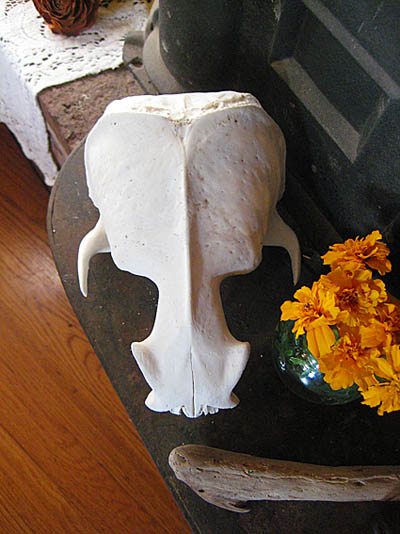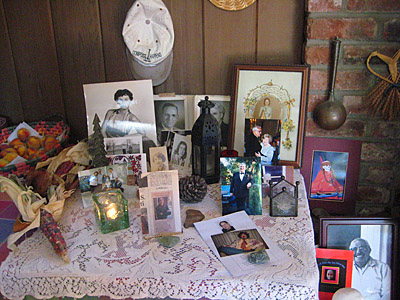
All Hallow’s Eve, Hallowe’en, Samhain, Day of the Dead, All Saints Day, All Souls Day, Dia de los Muertes. Another turn of the wheel. This sabbat is felt by some to be the holiest of all, when the veil between the worlds is said to be the thinnest, when we can invite our ancestors into our circles and be in ceremony with them. The holy day began on October 31 at sunset, the eve of All Hallow’s, and extends until tonight at sunset, or through the next two days as well, depending on how you celebrate this time.
The skull pictured above is I believe a seal skull. I found it on the beach at Half Moon Bay this summer. It’s completely intact and really very beautiful and smooth. There are many Celtic legends of selkies, women who turn into seals and back again, their possessive husbands hiding their seal skins so they will stay on the land, but they always return to the sea, their first home.
I am fortunate to live in an area where so many variations on a theme exist. Yesterday I took a new friend, who was raised Hindu, to my neighbor’s backyard, where we had been the night before sharing in their indigenous Mexica celebration of the ancestors. Central to the ritual was the ofrenda, the altar, which was made in traditional stairstep style, covered with a cloth and many photos of the beloved dead, many handmade and painted skulls, and many many flowers, mostly marigolds, but also dried corn stalks to make the perimeters and ears of multi-colored corn in a circle before the ofrenda, marking the four directions. Marigolds are used in Azteca and Hindu ceremony, and are profusely blooming in my neighbor’s yard as well as my husband’s plot over at the recycled water garden north of downtown San Jose. So they were plentiful for my own ofrenda as well. The ways of older cultures than my European one inform our pagan practice, borrowing what is best in an ever-changing way of being together in sacred space. Where we live is much about who lived here before us, as well as the ways of those who came from afar.

Our ancestors join our hearth altar on a table to the side of the woodstove that serves as the warm heart of our household. The weekend was full of tribal gatherings, music, celebration and food. Today it is quieter as we prepare to mark this liminal time, the sacred day of the dead around our own hearth.




I was fascinated by your account of the different cultures' celebrations of Hallowe'en. I wonder why the Christian church looks on it so negatively!
Glad you enjoyed this, Angie. History shows that the church overlaid the older pagan Celtic holiday with All Saint's Day and All Soul's Day (November 1 and 2, conveniently keeping the traditional three-day celebration around the sabbat). Many of the sabbats coincide with church holidays. The Romans and then the christians who followed them were very good at assimilating local culture into their own cultural and religious structures. I showed some of this in my Wheel of the Year card, which you can see at this link: http://proseandletters.com/Cards/WheeloftheYear.html
Cari, thank you so much for sharing. The seal skull touched my heart as these remnants of life gone by have so much energy connected to them still.